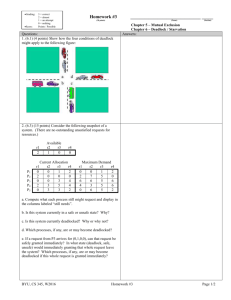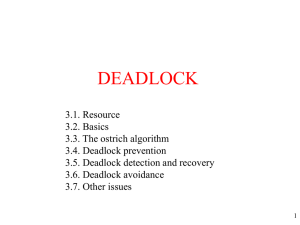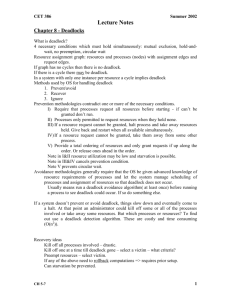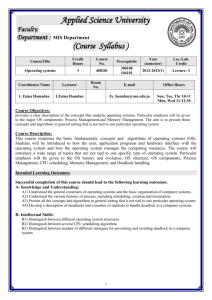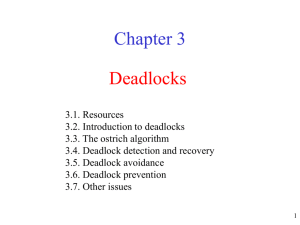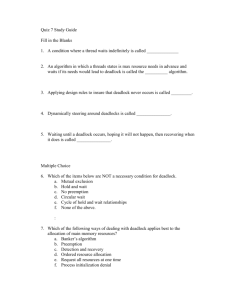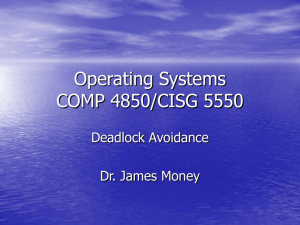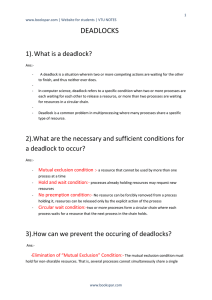Deadlocks
advertisement
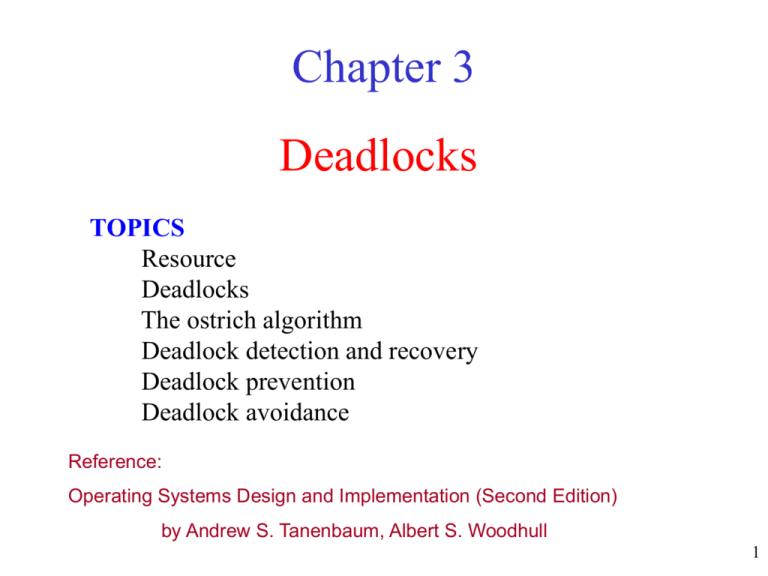
Chapter 3 Deadlocks TOPICS Resource Deadlocks The ostrich algorithm Deadlock detection and recovery Deadlock prevention Deadlock avoidance Reference: Operating Systems Design and Implementation (Second Edition) by Andrew S. Tanenbaum, Albert S. Woodhull 1 Resources(1) • Examples of computer resources – printers – tape drives – Tables 2 Resources (2) • Deadlocks occur when … – processes are granted exclusive access to devices – we refer to these devices generally as resources • Preemptable resources – can be taken away from a process with no ill effects – Example: process swapping form main memory • Nonpreemptable resources – will cause the process to fail if taken away – Example: print request by more than one proceses 3 Resources (3) • Sequence of events required to use a resource 1. request the resource 2. use the resource 3. release the resource • Must wait if request is denied – – requesting process may be blocked may fail with error code 4 Deadlocks • Suppose a process holds resource A and requests resource B – at same time another process holds B and requests A – both are blocked and remain so 5 Deadlock Modeling • Modeled with directed graphs – resource R assigned to process A – process B is requesting/waiting for resource S – process C and D are in deadlock over resources T and U 6 Four Conditions for Deadlock Four conditions must hold for there to be a deadlock: 1. Mutual exclusion condition • each resource assigned to 1 process or is available Hold and wait condition 2. • process holding resources can request additional No preemption condition 3. • previously granted resources cannot forcibly taken away Circular wait condition 4. • • must be a circular chain of 2 or more processes each is waiting for resource held by next member of the chain 7 How deadlock occurs A B C 8 How deadlock can be avoided (o) (p) (q) 9 Strategy to Deal with Deadlock Strategies for dealing with Deadlocks Just ignore the problem altogether Detection and recovery Prevention 1. 2. 3. • Negating one of the four necessary conditions of deadlock Dynamic avoidance 4. • Careful resource allocation 10 Strategy 1: The Ostrich Algorithm • Just ignore the problem • Reasonable if – deadlocks occur very rarely – cost of prevention is high • UNIX and Windows takes this approach • It is a trade off between – convenience – correctness 11 Strategy 2: Detection and Recovery Method 1: • Every time a resource is requested or released, the resource graph is updated, and a check is made to see if any cycle exist. • If a cycle exists, one of the process is the cycle is killed. If this does not break the deadlock, another process is killed and so on until the cycle is broken Method2 • Periodically check to see if there are any processes that have been continuously blocked for more than say 1 hour. Such processes are then killed 12 Strategy 3: Deadlock Prevention a) Attacking the Mutual Exclusion Condition • Some devices (such as printer) can be spooled – only the printer daemon uses printer resource – thus deadlock for printer eliminated • Not all devices can be spooled 13 b) Attacking the Hold and Wait Condition • Require processes to request resources before starting – A process is allowed to run if all resources it needed is available. Otherwise it will just wait. • Problems – May not know required resources at start of run – Resource will not be used optimally • Variation: – process must give up all resources and – then request all immediately needed 14 c) Attacking the No Preemption Condition • This is not a viable option • Consider a process given the printer – halfway through its job – now forcibly take away printer – !!?? 15 d) Attacking the Circular Wait Condition Numerically ordered resources Resource Graph • A process may request 1st a printer, then tape dirve. But it may not request 1st a plotter, then a scanner. • Resource graph can never have cycle. 16 Deadlock Prevention Summary 17 Strategy 4: Deadlock Avoidance • Carefully analyze each resource request to see if it can be safely granted. • Need an algorithm that can always avoid deadlock by making right choice all the time. • Banker’s algorithm (by Dijkstra) 18 Deadlock Avoidance Resource Trajectories Two process resource trajectories 19 Safe and Unsafe States (1) (a) (b) (c) (d) (e) Demonstration that the state in (a) is safe 20 Safe and Unsafe States (2) (a) safe (b) unsafe (c) safe (d) safe 21 The Banker's Algorithm for a Single Resource (a) (b) safe safe (c) unsafe Three resource allocation states 22 Banker's Algorithm for Multiple Resources Example of banker's algorithm with multiple resources 23



